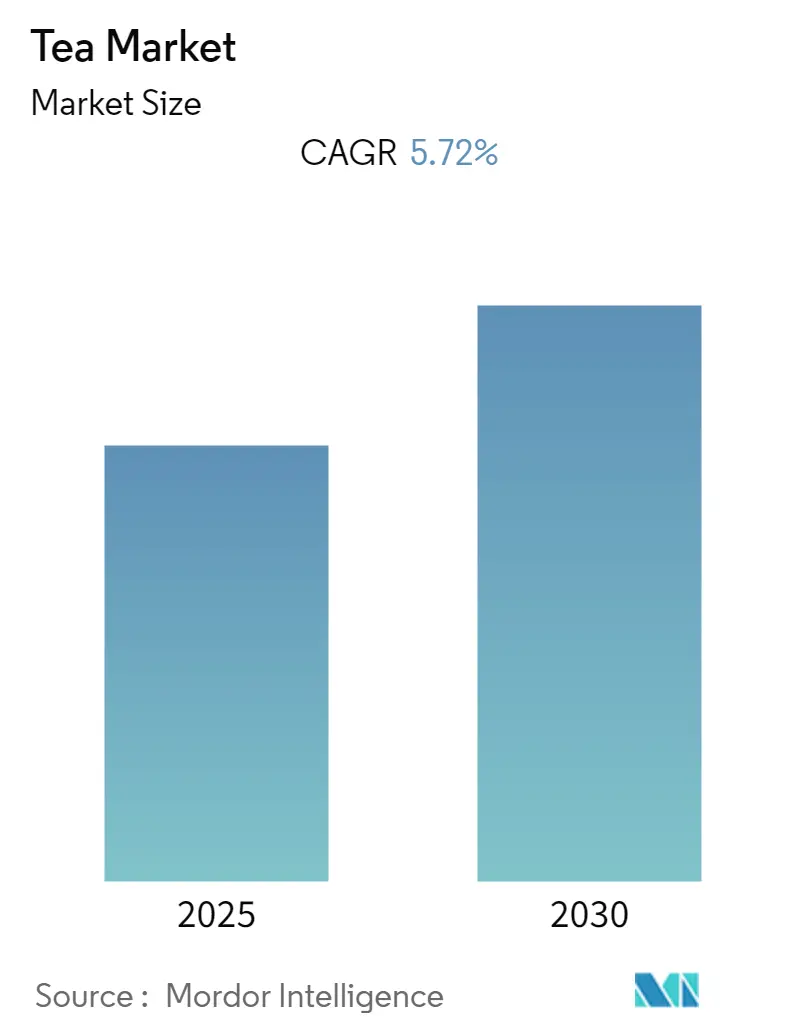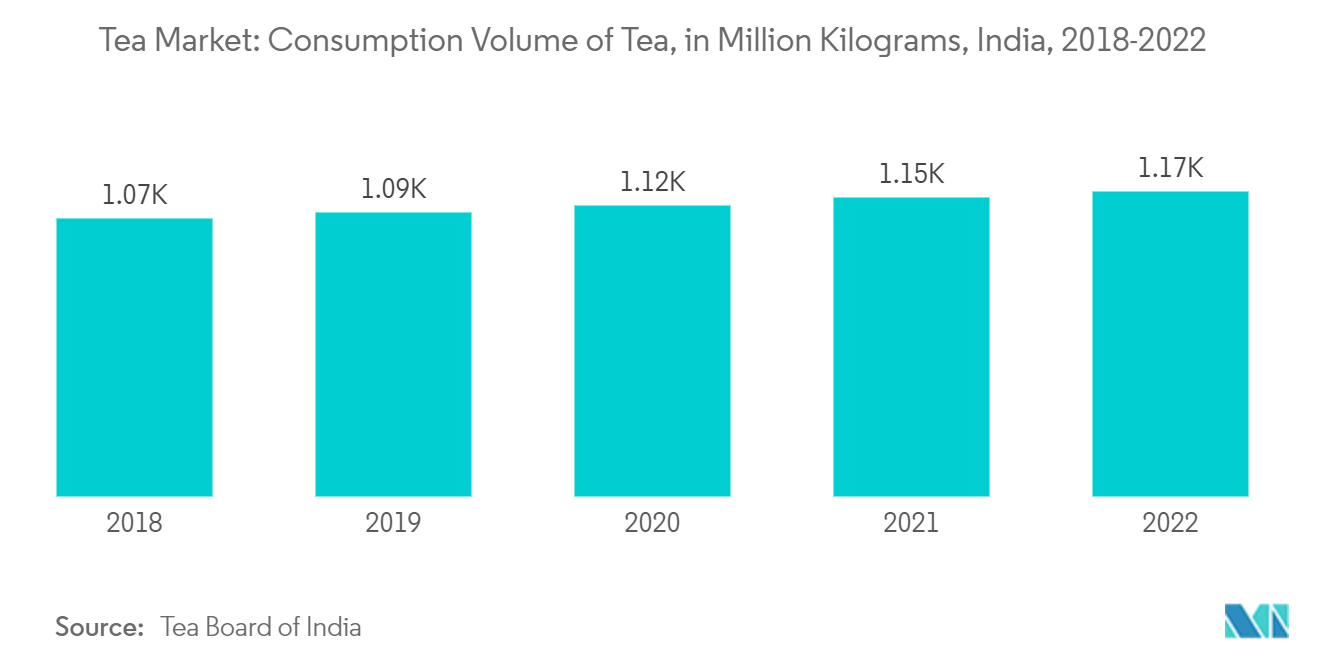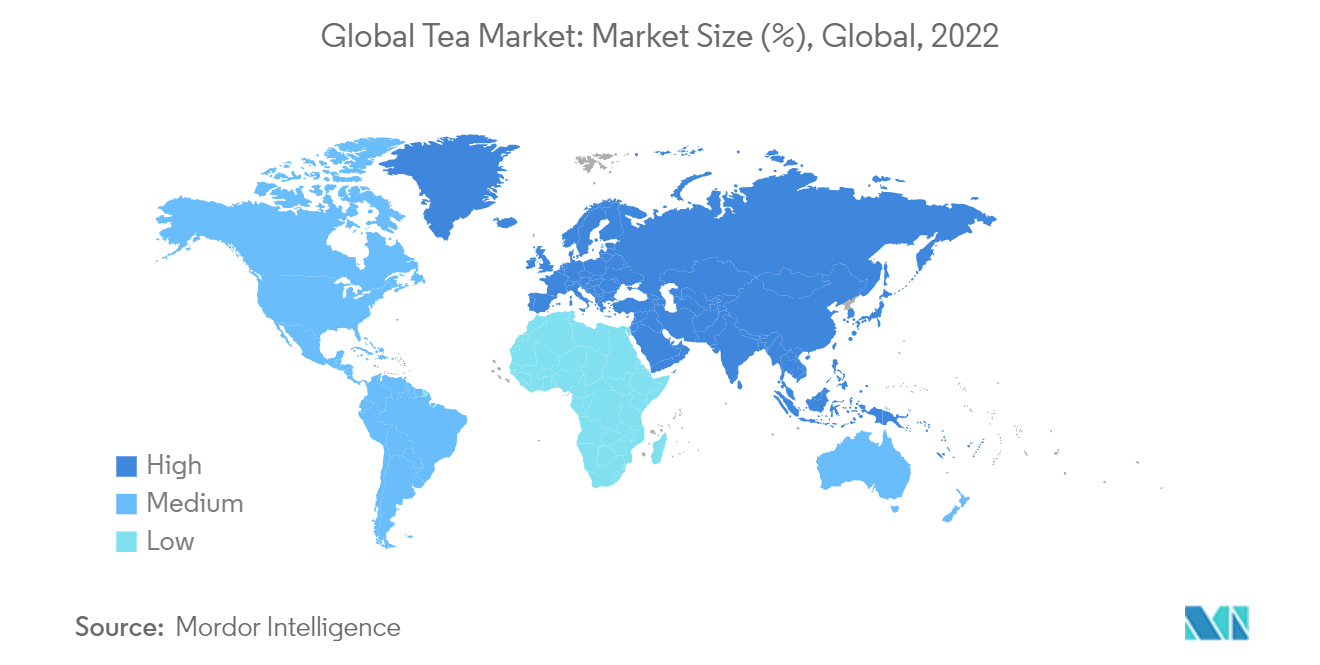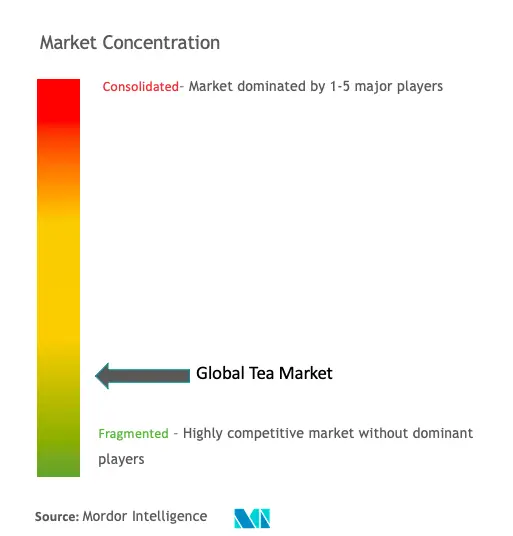Tea Market Analysis
The Tea Market is expected to register a CAGR of 5.72% during the forecast period.
- Health benefits associated with consuming tea and increased awareness related to carbonated drinks among people are some of the major factors boosting the demand for tea globally. The flavonoids, antioxidants, and phytochemicals present in tea help improve various functions of the human body.
- The increasing knowledge about the benefits of drinking tea for patients suffering from combat arthritis, cardiovascular diseases, and high blood pressure is likely to pave the way for the market's growth in the coming years. Moreover, a rise in disposable income, a shift in the tastes of people, and the introduction of additional healthy ingredients in tea by different market players are the other factors that fuel the market growth.
- The introduction of specialty iced teas is likely to be one of the major trends that will gain traction in the tea market over the forecast period. Vendors are introducing specialty iced teas by customizing different blends. Additionally, the popularity of organic label and herbal teas is also rising owing to increasing popularity. This can be attributed to their health benefits and enhanced benefits of ingredients such as basil, tulsi, etc., shifting consumer preferences toward natural ingredients-based products.
- For instance, in 2021, the German Tea & Herbal Infusions Association reported a surge in sales of organic quality teas, herbal infusions, and fruit infusions, with 15.9% of teas sold bearing the organic label. Also, from 2020 to 2021, the percentage of organic herbal and fruit infusions rose by 10.4%, reflecting a shifting consumer preference. This, in turn, is boosting the overall market for tea globally.
Tea Market Trends
Health Benefits of Tea is Propelling the Market Growth
- Tea consumption is majorly driven by consumers' search for new non-alcoholic beverages over fruit juices and carbonated drinks. Consumers are developing an affinity for tea due to its bag version, which offers enhanced convenience, thus, providing a suitable, convenient, and healthy alternative to juices and carbonates.
- Market players are launching new and healthy tea products, which are attracting consumers across the world. Tea provides hydration, instant refreshment, and stimulating effects that are beneficial for consumer health. Various herbal variants with fortified nutrients in different sizes and flavors are available in the market, propelling its growth. Market players are launching ayurvedic and herbal tea in the market to attract consumers.
- For instance, in June 2022, the United Kingdom-based Clipper Tea Company expanded its product range in the United States with new packaging and flavors. The newly added flavors include organic earl grey black tea, organic orange & turmeric herbal tea, organic green tea & lemon, organic winter apple and cinnamon herbal tea, and organic winter berries herbal tea.
Asia Pacific Holds Largest Segment
- Health benefits associated with consuming tea and increasing awareness of the harmful effects of carbonated drinks among people are significant factors increasing the demand for tea in the Asia-Pacific region. The increasing knowledge about the benefits of drinking tea for consumers with arthritis, cardiovascular diseases, and high blood pressure is likely to pave the way for market growth in the future. Black tea remains the most popular bottle, with green tea gaining popularity primarily due to the preferences of health-conscious consumers.
- Due to increasing innovation like different tea flavors, Gen Z and millennials are attracted to consumption of it. Additionally, the working population in the region prefers tea for instant energy and hydration during working hours. Owing to all these factors, the market players are launching healthy and flavorful tea products in the market to cater to consumer demand.
- In November 2022, Netsurf Network launched a series of herbal teas in India. The products are available in different herbal flavors, i.e., Bramhi & cinnamon, ginger & cumin, ashwagandha & lemon, and others.
Tea Industry Overview
The tea market is highly competitive, with strong competitors and a diversified product portfolio, which leads to intense competition among the existing players. The leading players in the tea market include Associated British Foods plc, RC Bigelow Inc, Apeejay Surrendra Group, Ekaterra, and Tata Consumer Products. Consumers in the market are craving new and innovative products to accommodate their personal life.
Companies are constantly trying to offer consumers new and innovative launches that meet their demands to capitalize on this trend. Key players have intensely embarked on the industry consolidation by leveraging their distribution network, entering partnerships with local distributors, especially in emerging economies, and developing new products.
Tea Market Leaders
-
Associated British Foods plc
-
RC Bigelow Inc
-
Apeejay Surrendra Group
-
Tata Consumer Products
-
Ekaterra
- *Disclaimer: Major Players sorted in no particular order
Tea Market News
- November 2022: Dabur India Limited launched Dabur Vedic Tea, a premium black tea that contains 30+ ayurvedic herbs that provide health benefits and boosts immunity. The product contains herbs like Tulsi, Ginger, Cardamom, and others.
- November 2022: Tata Consumer Products expanded its green tea portfolio with the launch of Tetley Green Tea with tulsi flavor. Green tea improves immunity and is rich in vitamin C.
- July 2022: CVC Capital Partners Fund VIII completed the purchase of Ekaterra, the tea business owned by Unilever. A cash-free, debt-free sale of Ekaterra was agreed upon between Unilever and CVC in November 2021 for EUR 4.5 billion (USD 4.83 billion).
Tea Industry Segmentation
This tea market accounts for tea beverages commonly prepared by pouring hot or boiling water over cured or fresh leaves of Camellia sinensis and other teas like black tea, green tea, and herbal tea.
The tea market is segmented by form, product type, distribution channels, and geography. Based on form, the market studied is segmented into leaf tea and CTC tea. Based on product type, the market is segmented into black tea, green tea, herbal tea, and other product types. Whereas based on distribution channels, the market is segmented into supermarkets/ hypermarkets, specialist retailers, convenience stores, and other distribution channels. Based on geography, the market is segmented into North America, Europe, Asia-Pacific, South America, Middle-East & Africa.
The market sizing has been done in value terms in USD for all the abovementioned segments.
| Form | Leaf Tea | ||
| CTC Tea | |||
| Other Forms | |||
| Product Type | Black Tea | ||
| Green Tea | |||
| Herbal Tea | |||
| Other Product Types | |||
| Distribution Channel | Supermarkets/Hypermarkets | ||
| Specialist Retailers | |||
| Convenience Stores | |||
| Other Distribution Channels | |||
| Geography | North America | United States | |
| Canada | |||
| Mexico | |||
| Rest of North America | |||
| Europe | United Kingdom | ||
| Germany | |||
| France | |||
| Spain | |||
| Italy | |||
| Russia | |||
| Rest of Europe | |||
| Asia-Pacific | China | ||
| Japan | |||
| India | |||
| Australia | |||
| Rest of Asia-Pacific | |||
| South America | Brazil | ||
| Argentina | |||
| Rest of South America | |||
| Middle-East and Africa | South Africa | ||
| United Arab Emirates | |||
| Rest of Middle-East and Africa | |||
Tea Market Research FAQs
What is the current Tea Market size?
The Tea Market is projected to register a CAGR of 5.72% during the forecast period (2025-2030)
Who are the key players in Tea Market?
Associated British Foods plc, RC Bigelow Inc, Apeejay Surrendra Group, Tata Consumer Products and Ekaterra are the major companies operating in the Tea Market.
Which is the fastest growing region in Tea Market?
Europe is estimated to grow at the highest CAGR over the forecast period (2025-2030).
Which region has the biggest share in Tea Market?
In 2025, the Asia Pacific accounts for the largest market share in Tea Market.
What years does this Tea Market cover?
The report covers the Tea Market historical market size for years: 2019, 2020, 2021, 2022, 2023 and 2024. The report also forecasts the Tea Market size for years: 2025, 2026, 2027, 2028, 2029 and 2030.
Our Best Selling Reports
Tea Industry Report
The global tea market growth is fueled by rising awareness of tea's health benefits, its use in cosmetics, and growing demand for organic tea. The market sees a trend of customers with disposable incomes spending more on premium blends and ingredients targeted at health conditions. Black, green, and herbal teas remain global favorites, while specialty teas for specific health concerns are gaining traction. Despite this growth, competition from other beverages is a significant market challenge, particularly among younger consumers. A historical overview and a market forecast outlook are available as a free report PDF download.

.webp)





